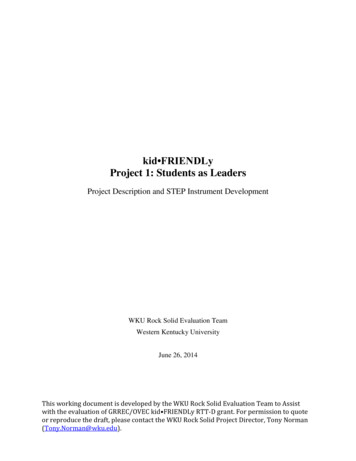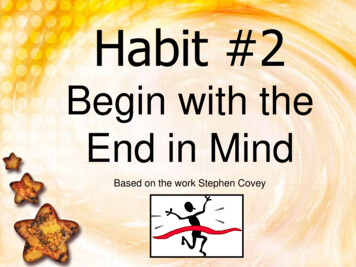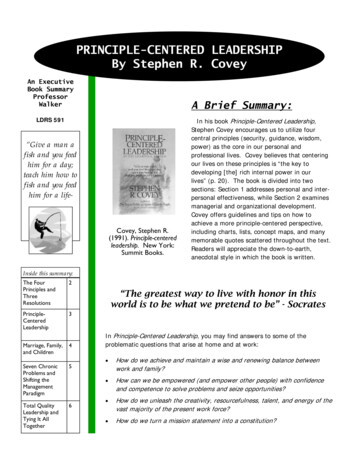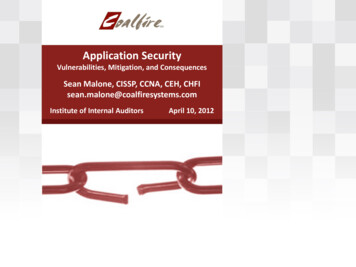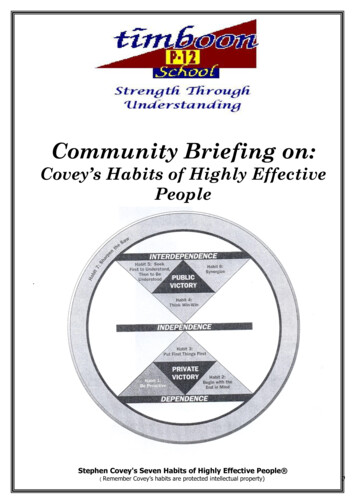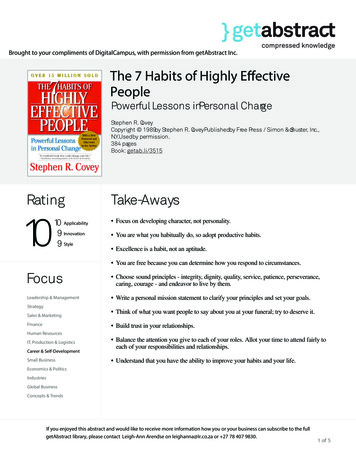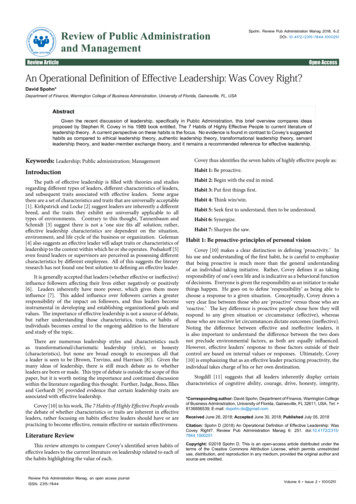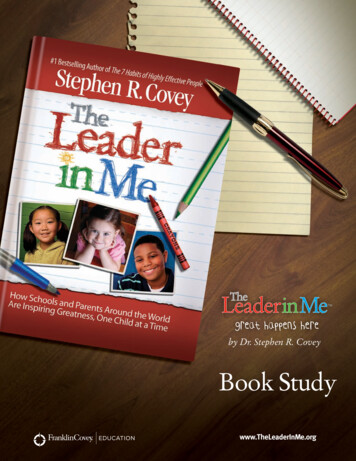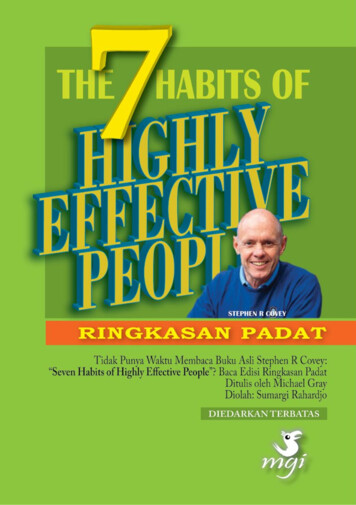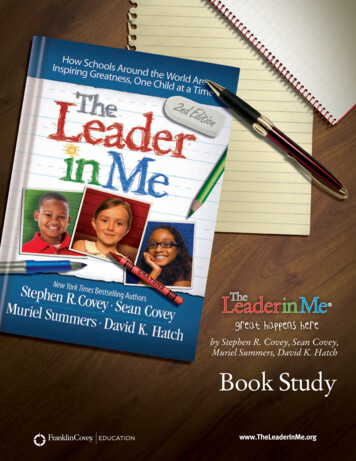
Transcription
by Stephen R. Covey, Sean Covey,Muriel Summers, David K. HatchBook Studywww.TheLeaderInMe.org
Table of ContentsCHAPTER 1 Too Good to Be True?. 2 ow It Started—And Why. 4CHAPTER 2 HCHAPTER 3 Teaching the 7 Habits. 6CHAPTER 4 Creating a Leadership Culture. 8CHAPTER 5 Achieving School Goals. 10CHAPTER 6 Bringing It Home. 12CHAPTER 7 Engaging the Community. 14CHAPTER 8 Shifting to Secondary and Beyond. 16CHAPTER 9 Keeping It Alive. 18CHAPTER 10 Ending With the Beginning in Mind. 20For the Facilitator . 22The Leader in Me . 25
Book StudyThe Leader in MeDiscussion QuestionsChapter 1: Too Good to Be True?Chapter 1 sets the tone of the book and begins to explain how and why leadership principlesfit today’s realities.1. In the beginning pages, it talks about how just entering the front doors of A.B. Combs was anengaging experience. What examples were given? 2. “Engaging” is a powerful word. What word would you use to describe our school?3. W hat are the “people skills” that were highlighted? Do you agree that these skills are moreimportant than ever? Why?4. What might be gained from stepping back and identifying, amplifying, and finding a niche forstudents’ and adults’ strengths and virtues?5. What are the three overarching themes to look for in the book?6. What one thing are you looking forward to reading more about in the remaining chapters?2The Leader in Me Book Study FranklinCovey All rights reserved.
Notes FranklinCovey All rights reserved.The Leader in Me Book Study3
Chapter 2: How It Started—And Why Chapter 2 continues to provide context as it describes how The Leader in Me got started—and why.1. Do you agree that schools do not behave, people do?2. Why did Muriel need to “reinvent her school”? 3. When asked what they wanted from a school, what was the common thread heard fromparents, community members, teachers, and students?4. If you were asked what you wanted from a school, would you answer similarly?5. “To Develop Leaders One Child at a Time” is the mission statement A.B. Combs created.How do you think this mission statement changed their behavior?6. How are academics, culture, and leadership intertwined?7. What is the definition of leadership Dr. Covey used?8. What is the ultimate end in mind of The Leader in Me?9. Would you want your child or grandchild to attend a school like A.B. Combs? Why or why not?Consider the Personal Reflection questions at the end of this chapter before we meet next time.4The Leader in Me Book Study FranklinCovey All rights reserved.
Notes FranklinCovey All rights reserved.The Leader in Me Book Study5
Chapter 3: Teaching the 7 HabitsChapters 3–5 delve into the how—how The Leader in Me helps schools address the threeevolving challenges and how educators are seeing it as “not one more thing but a better wayof doing what we are already doing.”1. What thoughts did you have on the Personal Reflection questions at the end of Chapter 2? 2. Why do you think the 7 Habits are considered to be timeless principles?3. Independence is an important accomplishment for a child. Why not stop there?4. How is the ubiquitous approach different from other initiatives?5. What is an example of teaching a habit through the integrated approach?6. What is an example of teaching a habit through a direct lesson?7. What is an example of teaching a habit through modeling?8. How can specialist teachers be involved with The Leader in Me?9. How can nonclassroom teachers be involved with The Leader in Me?10. What are the benefits of students teaching the habits?Consider the Personal Reflection questions at the end of this chapter before we meet next time.6The Leader in Me Book Study FranklinCovey All rights reserved.
Notes FranklinCovey All rights reserved.The Leader in Me Book Study7
Chapter 4: C reating a Leadership CultureChapters 3–5 delve into the how—how The Leader in Me helps schools address the threeevolving challenges and how educators are seeing it as “not one more thing but a better wayof doing what we are already doing.”1. What thoughts did you have on the Personal Reflection questions at the end of Chapter 3? 2. What is the difference between a “culture by design” and a “culture by chance”?3. How would engaging our students, staff, and parents help each feel an ownership with the school?4. What are the benefits of a common language?5. How can we build our “interior designer” skills?6. What does “leadership is a choice, not a position” mean?7. What are three ways to involve students as leaders?8. What is the highest level of giving students leadership responsibilities?9. Which events do we currently have that could incorporate student leadership?10. What are some of the differences between leadership and management?Consider the Personal Reflection questions at the end of this chapter before we meet next time.8The Leader in Me Book Study FranklinCovey All rights reserved.
Notes FranklinCovey All rights reserved.The Leader in Me Book Study9
Chapter 5: A chieving School GoalsChapters 3–5 delve into the how—how The Leader in Me helps schools address the threeevolving challenges and how educators are seeing it as “not one more thing but a better wayof doing what we are already doing.”1. What thoughts did you have on the Personal Reflection questions at the end of Chapter 4? 2. Why is it important to focus on only one or two Wildly Important Goals?3. What are the four steps to setting and tracking goals?4. What are the benefits of sharing and discussing data with students?5. How does the alignment of schoolwide, classroom, and individual goals facilitate progress?6. What role do scoreboards play in sustaining excitement around goals?7. Which of the three tools that augment the goal-setting process are you most curious to try?8. What role do paradigms play in the goal-setting process? Consider the Personal Reflection questions at the end of this chapter before we meet next time.10The Leader in Me Book Study FranklinCovey All rights reserved.
Notes FranklinCovey All rights reserved.The Leader in Me Book Study11
Chapter 6: B ringing It HomeChapters 6 and 7 reveal how schools are engaging parents and community members tostrengthen, lengthen, and widen the impact of The Leader in Me.1. What thoughts did you have on the Personal Reflection questions at the end of Chapter 5? 2. What are the benefits of the same common language being used at school and at home?3. Which suggestion for engaging families sounds most exciting for our school?4. What message does staff modeling of the 7 Habits send to students and their families?5. What do the walls of your home communicate to family members and visitors?6. How can we share the ideas in this chapter with our families?Consider the Personal Reflection questions at the end of this chapter before we meet next time.12The Leader in Me Book Study FranklinCovey All rights reserved.
Notes FranklinCovey All rights reserved.The Leader in Me Book Study13
Chapter 7: Engaging the Community Chapters 6 and 7 reveal how schools are engaging parents and community members tostrengthen, lengthen, and widen the impact of The Leader in Me.1. What thoughts did you have on the Personal Reflection questions at the end of Chapter 6? 2. Do we have a “Donnie Lane” in our community?3. Which local organizations have the same end in mind as The Leader in Me?4. What are the benefits of a good workforce to our community?5. According to several sponsoring agencies, which voids does The Leader in Me address?6. Aside from financial assistance, what other ways are business organizations getting involvedwith Leader in Me Schools?Consider the Personal Reflection questions at the end of this chapter before we meet next time.14The Leader in Me Book Study FranklinCovey All rights reserved.
Notes FranklinCovey All rights reserved.The Leader in Me Book Study15
Chapter 8: Shifting to Secondary and Beyond While most examples in the book come from elementary schools, the same process can beapplied to secondary schools with some adaptation. Chapter 8 focuses on secondary schools.1. What thoughts did you have on the Personal Reflection questions at the end of Chapter 7? 2. What are the biggest challenges in taking The Leader in Me to secondary schools?3. What encourages engagement in a secondary student?4. Why is the use of a strong role model to teach the 7 Habits important at the secondary level?5. I n our school, what scheduling opportunities do we have for teaching the 7 Habits (our“somewhere”)?6. How would we communicate what was taught during our “somewhere” with the teachers whoare not involved in directly teaching the content?7. What instructional strategies have been successful with secondary students?8. Which of the examples that help students feel connected is most exciting to you?9. What are we currently doing that students could be doing?10. Does our school mission statement illustrate who we are and what is important to us?Consider the Personal Reflection questions at the end of this chapter before we meet next time.16The Leader in Me Book Study FranklinCovey All rights reserved.
Notes FranklinCovey All rights reserved.The Leader in Me Book Study17
Chapter 9: K eeping It AliveBest practices for how to launch and sustain The Leader in Me over time are covered in Chapter 9.1. What thoughts did you have on the Personal Reflection questions at the end of Chapter 8? 2. Why is it important not to “boil someone else’s water” when implementing The Leader in Me?3. W hat are some of the lessons learned from schools that have successfully implemented andmaintained The Leader in Me?4. What is the difference between a school that is principle-centered and a school that isprincipal-centered?5. What outcomes would we be trying to achieve with The Leader in Me?6. Why is it so important to embed leadership into the systems of a school?7. What are the pivotal paradigms necessary to launch and sustain The Leader in Me?8. Why are paradigms so important?Consider the Personal Reflection questions at the end of this chapter before we meet next time.18The Leader in Me Book Study FranklinCovey All rights reserved.
Notes FranklinCovey All rights reserved.The Leader in Me Book Study19
Chapter 10: Ending With the Beginning in MindChapter 10 is a summary reminder of why The Leader in Me is vitally important in today’s reality.1. What thoughts did you have on the Personal Reflection questions at the end of Chapter 9? 2. What do you think is unique about The Leader in Me?3. W hat would be the impact of focusing on students’ strengths instead of focusing on students’deficits?4. Why do educators feel like this is not “one more thing”?5. How is The Leader in Me like the operating system on a computer?6. Are the primary and secondary purposes of The Leader in Me worthwhile pursuits forour school?Consider the Personal Reflection questions at the end of this chapter.20The Leader in Me Book Study FranklinCovey All rights reserved.
Notes FranklinCovey All rights reserved.The Leader in Me Book Study21
FOR THE FACILITATORDefinition of a book study:A group of people who meet regularly to discuss a book they are reading.General Tips R EAD THE BOOK. This may seem obvious, but it is the most important step, so it is worth stating.It is a good idea to plan on finishing each chapter a little earlier than you might do otherwise sothat you have time to think about it and prepare before meetings. WRITE DOWN IMPORTANT PAGE NUMBERS. If there are parts of the book that made an impacton you or that you think may come up in discussion, write down the page numbers so that youcan access the passages easily while preparing and leading the discussion. LET OTHERS ANSWER FIRST. When you are asking questions, you want to facilitate discussion.By letting others answer first, you will promote conversation and help everyone feel like theiropinions matter. Note: Sometimes people may need to take time to think before they answer.Part of being a good facilitator is being comfortable with silence. Don’t feel like you have to jumpin if no one answers immediately. GET EVERYONE INVOLVED. Each member should assume responsibility for the success of thediscussion. To keep the conversation moving, ask participants to elaborate or explain more fullya previous comment or to restate their comment in a different way. Encourage participants torelate the contents to their own experiences. ENCOURAGE PARTICIPANTS TO QUESTION AND COMMENT. Participants should be encouraged towrite questions and comments while they are reading and bring them to each meeting. MAKE CONNECTIONS BETWEEN COMMENTS. If someone gives an answer to Question 2 thatconnects well with Question 5, don’t feel obligated to ask Questions 3 and 4 before moving to 5.You are the facilitator. Even if you go in order, try to find a link between an answer and the nextquestion. By connecting people’s comments to the questions, you’ll help build momentum in theconversation. OCCASIONALLY, DIRECT QUESTIONS TOWARD QUIET PEOPLE. You don’t want to put anyone onthe spot, but you want everyone to know their opinions are valued. If you have a few talkativepeople who always jump right in, directing a question to a specific person may help draw out thequieter people (and let the talkative people know it is time to give someone else a turn). LAN STRATEGIES FOR REFOCUSING. Keep the discussion “on track” and solicit ideas andPcomments from all participants. If a discussion veers off track, offer to discuss it after the meetingwith anyone who is interested. DON’T FEEL OBLIGATED TO GET THROUGH ALL THE QUESTIONS. The best questions sometimeslead to intense conversations. That’s a good thing! The questions are there as a guide. It maybe rare that you finish all of the questions. Respect people’s time by wrapping up the discussionwhen the meeting time is over rather than pushing on until you finish everything you planned. 22CLOSE EACH SESSION. Plan a summarizing activity, question, or assignment.The Leader in Me Book Study FranklinCovey All rights reserved.
Structuring the DiscussionYou may choose to use some of the following “discussion starters” as you facilitate thediscussion. PARTNER INTERVIEWS. Participants interview one another to get different viewpoints on a topic. JIGSAW. (Places great emphasis on cooperation and shared responsibility within groups.)1. Divide the group into smaller groups.2. Divide the chapter(s) of reading into roughly equal parts.3. Assign each smaller group one of the parts.4. At the following meeting, have each small group discuss their part and come to a consensuson the main points to share with the larger group.5. Make sure everyone participates. TABLE TALK. Allow for discussion at each table with the intent to share with the larger groupafter a specific time period. POWERPOINT . Pose a question on the screen and collect whole-group feedback on a poster.Opening the MeetingsAsk members for a great idea they tried that was successful.Ask members a question they may have and need help finding the answer to. FranklinCovey All rights reserved.The Leader in Me Book Study23
FOR THE FACILITATORConcluding the Book StudyInstruct participants to write what they have learned from the book on stickynotes. Place each sticky note on a large chart paper that has been dividedinto sections such as “My Ideal School,” “Potential,” “Student Leadership,”“Strategies,” “Culture,” “Families,” “Paradigms,” etc.Decide Next StepsDecide whether the group would like to know more about The Leader in Me process.24 Whatshould be our next steps? Who is responsible for the next steps?The Leader in Me Book Study FranklinCovey All rights reserved.
Will Your School or ChildBe the Next Leader in MeSuccess Story?Drawing from the best practices and thought leadership of successful educatorsaround the world, FranklinCovey’s Leader in Me process will help schools developstudents who are ready to succeed in the 21st century, with critical skills andcharacteristics such as: Trust and trustworthiness Effective interpersonal skills Strong work ethic Sense of teamwork Motivation and initiative Valuing diversity in aglobal market Problem-solving skills Goal settingWhat’s more, schools will enjoy a culture in which discipline referrals decrease, testscores improve, and engaged staff members contribute the highest and best of theirtalents and efforts.Help put the schools in your community on the path to greatness.For more information about how investing in The Leader in Me can help put the schools inyour community on the path to greatness, please contact FranklinCovey’s Education Practiceby calling 1-800-272-6839 or by email at Educate@FranklinCovey.com. Or visit www.TheLeaderInMe.org.You can also visit www.franklincovey.com/education. FranklinCovey All rights reserved.The Leader in Me Book Study25
7 7 0 2 8The Leader in Me Book Study733065 770280Made in U.S.A.ENGLISH FranklinCovey. All rights reserved.EDU141222 Version 2.0.0
by Stephen R. Covey, Sean Covey, Muriel Summers, David K. Hatch . . Why do you think the 7 Habits are considered to be timeless principles? 3. Independence is an important accomplishment for a child. Why not stop there? 4. How is the
